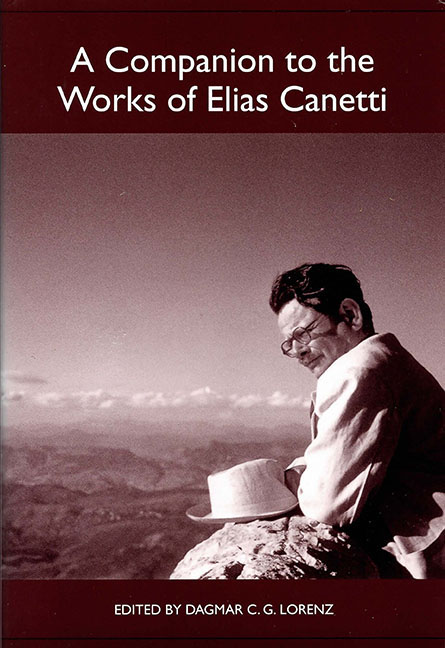Book contents
- Frontmatter
- Dedication
- Contents
- Canetti's Principal Works
- Abbreviations of Works Frequently Cited
- Introduction
- Canetti's Global Significance
- Writing and Language
- The Works: Themes and Genres
- Philosophy and Social Thought
- Canetti and Nietzsche: An Introduction to Masse und Macht
- Images of Male and Female in Canetti's Fictional, Autobiographical, and Theoretical Work
- Canetti's Final Frontier: The Animal
- Historical Contexts
- Works Cited
- Notes on the Contributors
- Index
Images of Male and Female in Canetti's Fictional, Autobiographical, and Theoretical Work
from Philosophy and Social Thought
Published online by Cambridge University Press: 28 April 2017
- Frontmatter
- Dedication
- Contents
- Canetti's Principal Works
- Abbreviations of Works Frequently Cited
- Introduction
- Canetti's Global Significance
- Writing and Language
- The Works: Themes and Genres
- Philosophy and Social Thought
- Canetti and Nietzsche: An Introduction to Masse und Macht
- Images of Male and Female in Canetti's Fictional, Autobiographical, and Theoretical Work
- Canetti's Final Frontier: The Animal
- Historical Contexts
- Works Cited
- Notes on the Contributors
- Index
Summary
Dealing with images of male and female, and gender relationships in general in Canetti's works is a tricky task. Differing from many of the prominent representatives of Viennese modernism, Canetti avoids theories that claim to reveal the secrets of gender identity and sexuality. In one of the volumes of his autobiography, Das Augenspiel, he describes the predominance of psychoanalytic discourses in the intellectual circles of postwar Vienna:
Im allgemeinen war es [. . .] so, daß zu jener Zeit in Gesprächen nichts gesagt werden konnte, ohne daß es durch die Motive, die dafür sofort bei der Hand waren, entkräftet wurde. Daß für alles dieselben Motive gefunden wurde, die unsägliche Langeweile, die sich von ihnen verbreitete, die Sterilität, die daraus resultierte, schien wenige zu stören.
The “motives” Canetti mentions are sexual ones, and the patterns of explanation are derived from Freud's libido theory; Canetti criticizes the psychoanalytic “obsession” that took hold of writers such as Hermann Broch. He objects to all theories and literary works that regard the sexual forces as gods or quasi natural laws. In particular, he objects to the Freudian approach based on libido and thanatos.
Canetti carefully observed the profound social, cultural, and political changes and contradictions after the fall of the Danube monarchy, and he looked for new ways to comprehend them: “Was immer geschah — es geschah ungeheuer viel und es stürzte rapid noch viel mehr zu —, es war durch keine gängige Theorie zu begreifen” (A, 267). Statements like this imply the negation of all “master theories” and at the same time show the birth of a new one.
Early on Canetti used different modes of writing and investigation: while working on the fictional representations in the novel Die Blendung and in his dramas he began his study of crowds and power, which eventually led to the publication of Masse und Macht. He developed his own forms of expression in constant communication with other writers and intellectuals, as his autobiographies clearly demonstrate, but at the same time he insisted on the complete independence of his own writing and thinking. This self-imposed isolation has motivated most interpreters of Canetti's writings to focus on the inherent structures of his work, the connections between the different genres the author used and the intentions he pursued.
- Type
- Chapter
- Information
- A Companion to the Works of Elias Canetti , pp. 217 - 238Publisher: Boydell & BrewerPrint publication year: 2004



